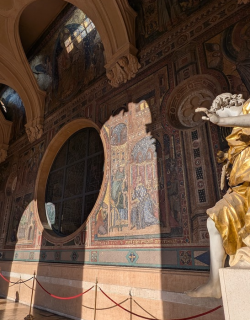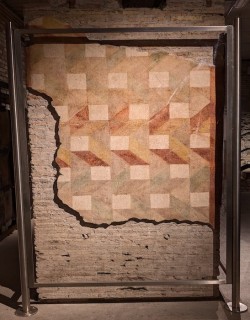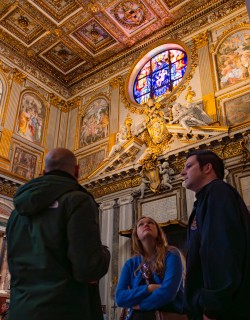When you enter this beautiful medieval church in Rome, the first thing you notice is the size: the old wooden door through which you have to walk is so small and humble that it doesn’t give any clue of the building’s grandiosity. But once you get used to it and you start looking around, the first thing that catches your eye is the shimmering light, reflected on the golden mosaic of the apse. Dating back to the 12th century, the beautiful mosaic of St. Clement’s Basilica hides a very deep spiritual symbolism, which was meant to inspire the faithful, talking to his heart and mind.
The triumphal arch
On the arch that frames the apse, the so-called “triumphal arch”, we find a series of characters, each one of them identified by an inscription. On the left, we recognize Saint Lawrence, Saint Paul and the prophet Isaiah, while on the right we see Saint Peter, Saint Clement and the prophet Jeremiah. On the very top of the arch, there is an impressive portrait of Jesus, holding the Bible and raising his right hand in the gesture of blessing, as used by the Roman Catholic Church. We can also notice four strange winged figures flying towards Jesus: a lion, an angel, an eagle and a bull. These are the four creatures who stand by the throne of God, as described in the Book of the Revelation by Saint John. Each one of them symbolically represents one of the Evangelists: the lion is St. Mark, the bull is St. Luke, the angel is St. Matthew and the eagle is St. John.
Let’s count sheep!
Let’s now look at the apse: in the lowest section of the decoration, we can see two groups of six sheep each, converging towards one single lamb, in the center, whose head is crowned by a glittering halo, made of actual gold: what does it mean? The twelve sheep are the Apostles, gathering around Jesus, the purest lamb who will open the Scroll of the Seven Seals, as written in the Book of the Revelations.
But there’s even more to that. Take a closer look, try to follow the groups of sheep: where are they coming from? You will notice that each group of lambs is actually coming out a little archway which is the gate of a city, represented with a total lack of perspective, as typical of those centuries, but still very interesting: pay attention to the little details, you will see the city walls, towers and buildings of all sorts. But which cities are we talking about?
Try to go a bit closer or to use the zoom of your camera and focus on the archways where the sheeps are coming through: you can actually read the names of the cities. On the right you’ll read “Hierusalem”, on the left “Bethlehem”. This is a symbolism that you can find very often in the ancient churches, most of the times associated with the lambs. What does it refer to? The two cities are meant to represent symbolically the two roots of the Christian Church of the origins: Jerusalem symbolizes the Jews who converted and recognized Jesus as the Messiah, while Bethlehem represents the gentiles, the pagans who renounced their gods and accepted Jesus. These two groups of people are the ones who formed the first community, when no one was born a Christian, but everybody came from a different religion.
The cross and the vine
Let’s move now to the central and bigger part of the mosaic, where we see the crucifixion of Jesus with the Virgin Mary and Saint John standing next to the cross.
So far nothing unusual. But let’s look closely and let’s discover the symbolism hidden in this iconography that looks so common, but it’s not.
On the cross you can notice the presence of a few white doves: what do they represent? Numbers are of great help when it comes to discover the meaning of a religious picture. So, like we did before with the lambs, if we want to know who these birds are representing, we have to count them: don’t forget to count also the little bird that is partially hidden at the base of the cross!
We have twelve doves in total: so again, the Apostles, in form of animals, are converging towards Christ. Above the head of Jesus, you can see a hand holding a crown: it’s the hand of God, coming out of a sort of colourful shell that is meant so symbolize the Heavens: He is putting the crown on the head of His Son.
Let’s now look at the base of the Cross: the wood is coming out of a bush of acanthus and, right under it, we can see two deers drinking the water of four little rivers, the rivers of the Garden of Eden. This motif is inspired from a quote from the Psalm 41:2 “sicut cervus desiderat ad fontes aquarum, ita desiderat anima mea ad te Deus” (As the deer longs for the springs of water, so my soul longs for you, oh God). So the deers represent the faithful who is drawn to God.
Let’s now follow the vines that seem to grow from the cross itself, spiraling all over the apse: what do they mean?
To answer this question, we will have to look at the little figures of people that we can find among the spirals. We can see them busy doing all sorts of activities: clerks, scholars, farmers and shepherds. All these people, wealthy and poor, women and men, despite their differences, are all connected to each other and to the cross, the new Tree of Life, just like Jesus said according to the Gospel: “I am the vine; you are the branches. If you remain in me and I in you, you will bear much fruit; apart from me you can do nothing” (John 15:5).
Opening hours to visit the church:
From Monday to Saturday 9:00-12:30 and 15:00-18:00
On Sundays and Holidays 12:15-18:00
Written by Francesca Romana Valente, Archaeologist and Licensed Guide in Rome


